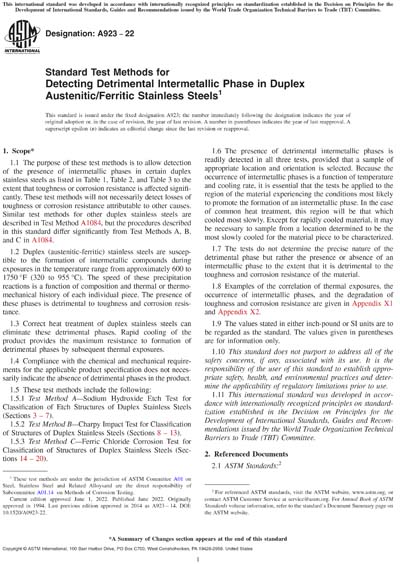Historical
ASTM A923-22
Standard Test Methods for Detecting Detrimental Intermetallic Phase in Duplex Austenitic/Ferritic Stainless Steels
1.1The purpose of these test methods is to allow detection of the presence of intermetallic phases in certain duplex stainless steels as listed in Table 1, Table 2, and Table 3 to the extent that toughness or corrosion resistance is affected significantly. These test methods will not necessarily detect losses of toughness or corrosion resistance attributable to other causes. Similar test methods for other duplex stainless steels are described in Test Method A1084, but the procedures described in this standard differ significantly from Test Methods A, B, and C in A1084.
1.2Duplex (austenitic-ferritic) stainless steels are susceptible to the formation of intermetallic compounds during exposures in the temperature range from approximately 600 to 1750 °F (320 to 955 °C). The speed of these precipitation reactions is a function of composition and thermal or thermomechanical history of each individual piece. The presence of these phases is detrimental to toughness and corrosion resistance.
1.3Correct heat treatment of duplex stainless steels can eliminate these detrimental phases. Rapid cooling of the product provides the maximum resistance to formation of detrimental phases by subsequent thermal exposures.
1.4Compliance with the chemical and mechanical requirements for the applicable product specification does not necessarily indicate the absence of detrimental phases in the product.
1.5These test methods include the following:
1.5.1Test Method A - Sodium Hydroxide Etch Test for Classification of Etch Structures of Duplex Stainless Steels (Sections 3 "“ 7).
1.5.2Test Method B - Charpy Impact Test for Classification of Structures of Duplex Stainless Steels (Sections 8 "“ 13).
1.5.3Test Method C - Ferric Chloride Corrosion Test for Classification of Structures of Duplex Stainless Steels (Sections 14 "“ 20).
1.6The presence of detrimental intermetallic phases is readily detected in all three tests, provided that a sample of appropriate location and orientation is selected. Because the occurrence of intermetallic phases is a function of temperature and cooling rate, it is essential that the tests be applied to the region of the material experiencing the conditions most likely to promote the formation of an intermetallic phase. In the case of common heat treatment, this region will be that which cooled most slowly. Except for rapidly cooled material, it may be necessary to sample from a location determined to be the most slowly cooled for the material piece to be characterized.
1.7The tests do not determine the precise nature of the detrimental phase but rather the presence or absence of an intermetallic phase to the extent that it is detrimental to the toughness and corrosion resistance of the material.
1.8Examples of the correlation of thermal exposures, the occurrence of intermetallic phases, and the degradation of toughness and corrosion resistance are given in Appendix X1 and Appendix X2.
1.9The values stated in either inch-pound or SI units are to be regarded as the standard. The values given in parentheses are for information only.
1.10This standard does not purport to address all of the safety concerns, if any, associated with its use. It is the responsibility of the user of this standard to establish appropriate safety, health, and environmental practices and determine the applicability of regulatory limitations prior to use.
1.11This international standard was developed in accordance with internationally recognized principles on standardization established in the Decision on Principles for the Development of International Standards, Guides and Recommendations issued by the World Trade Organization Technical Barriers to Trade (TBT) Committee.
Content Provider
ASTM International [astm]






